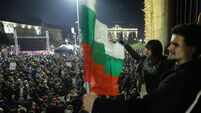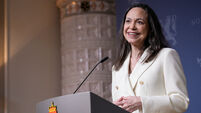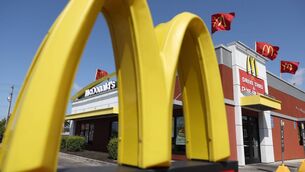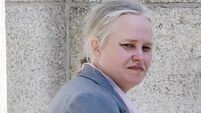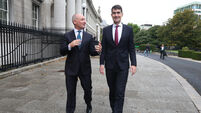White House considers sanctions against Syria
The White House has said it is considering sanctions against the Syrian regime, after the latest security crackdown against anti-government protestors.
At least 18 people are reported to have been killed after the army deployed tanks against demonstrators in Daraa.
White House Press Secretary Jay Carney said the US was urging a new approach from the Syrian leadership.
Meanwhile, a draft text is being prepared at the United Nations condemning the violence in Syria.
The UK, Germany and France are understood to be among the countries putting their name to the statement.
At least 18 people are reported to have been killed in the southern city of Daraa after thousands of soldiers backed by tanks and snipers descended on the city where Syria’s anti-government uprising began.
The troops opened fire indiscriminately on civilians and rounded up suspected protesters.
At least 11 people were killed and 14 others lay in the streets – either dead or gravely wounded, witnesses said.
Yesterday’s raids on Daraa and at least two other areas suggest Syria is trying to impose military control on the centres of protests against President Bashar Assad, whose family has ruled for four decades.
Residents and human rights activists said the regime wanted to terrify opponents and intimidate them against staging any more demonstrations.
At the United Nations, France, Britain, Germany and Portugal urged the UN Security Council to strongly condemn the violence against peaceful demonstrators and in Geneva, UN human rights chief Navi Pillay said Syria had turned its back on international calls to “stop killing its own people”.
Yesterday’s offensive was meticulously planned. Electricity, water and mobile phone services were cut, security agents armed with guns and knives conducted house-to-house sweeps, neighbourhoods were sectioned off and checkpoints were erected before the sun rose.
“They have snipers firing on everybody who is moving,” a witness said. “They aren’t discriminating. There are snipers on the mosque. They are firing at everybody.”
The massive assault on Daraa appeared to be part of new strategy of crippling, pre-emptive strikes against any opposition to Assad, rather than reacting to demonstrations. Other crackdowns and arrest sweeps were reported on the outskirts of Damascus and the coastal town of Jableh – bringing more international condemnation and threats of targeted sanctions by Washington.
The attack on Daraa, an impoverished city on the Jordanian border, was by far the biggest in scope and firepower. Video purportedly shot by activists showed tanks rolling through streets and grassy fields with soldiers on foot jogging behind them.
Witnesses said busloads of troops poured in before dawn and snipers took up positions on the roofs of houses and high buildings while other security agents searched houses for suspected protesters.
Daraa, a drought-parched region of 300,000 in the south, has seen some of the worst bloodshed over the past five weeks as the uprising gained momentum.
The area was ripe for unrest; the grip of Syria’s security forces is weaker on the border areas than around the capital Damascus, and Daraa has not benefited from recent years of economic growth.
It has also absorbed many rural migrants who can no longer farm after years of drought.
The city was where Syria’s uprising began in mid-March, touched off by the arrest of teenagers who scrawled anti-government graffiti on a wall.
A relentless crackdown since has killed more than 350 people throughout the country, with 120 alone dying over the weekend. But that has only emboldened protesters, who started with calls for modest reforms but are now increasingly demanding Assad’s downfall.
State-run television quoted a military source as saying army units entered the city to bring security “answering the pleas for help by residents of Daraa”.
Another military raid targeted the Damascus suburb of Douma, where rattling, heavy gunfire could still be heard last night.
In Jableh, men who tried to leave their houses were shot at by soldiers and thugs, three residents said, and only women were allowed on to the streets to buy food.
Syria has banned nearly all foreign media and restricted access to troublespots since the uprising began, making it almost impossible to verify the dramatic events shaking one of the most authoritarian anti-Western regimes in the Arab world.
Syria is a close ally of Iran and a backer of the militant groups Hezbollah in Lebanon and Hamas in Gaza.
Assad has blamed most of the unrest on a “foreign conspiracy” and armed thugs, and has used state media to push his accusations.
The violence has exacerbated sectarian tensions that had largely been kept in check under Assad’s iron rule and secular ideology. The majority of the population is Sunni Muslim, but Assad and the ruling elite belong to the minority Alawite sect, an offshoot of Islam’s Shiite branch that dominates in Iran, Iraq and Bahrain.
Unrest in Syria has repercussions well beyond its borders.
Syria has a pivotal role in most of the flashpoint issues of the Middle East - from the Arab-Israeli peace process to Iran’s widening influence. Instability has thrown into disarray the US push for engagement with Damascus, part of Washington’s hopes to peel the country away from Hamas, Hezbollah and Tehran.
The White House said yesterday it was considering sanctions against the Syrian government in response to the brutal crackdown – the first time officials had said publicly that sanctions were possible.
Syria already is subject to numerous penalties as it is deemed a “state sponsor of terrorism” by the US State Department, but it maintains diplomatic relations with Washington.







